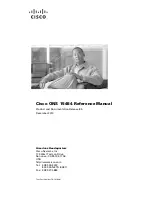
8
Instruction Leaflet
IL29C614F
Effective December 2011
Instructions for The Digitrip RMS 310 3-Pole and
4-Pole Trip Unit Installation and Operation with
K-Frame Series C Circuit Breakers
EATON CORPORATION
www.eaton.com
3.3.3 ACCESSORY INSTALLATION WITH GROUND
FAULT TRIP UNITS
If an accessory other than the auxiliary switch supplied with
the trip unit is to be used, install the accessory by using the
appropriate instruction leaflet listed in Section 8.2.
See wiring instructions below for special restric-
tions on accessory wiring for ground fault breakers.
Then install the ground fault alarm and neutral cur-
rent sensor connector printed circuit board as
described above.
LEADS COULD BE DAMAGED IF IN CONTACT WITH
MOVING PARTS. ACCESSORY WIRES SHOULD BE
FORMED AND ROUTED TO CLEAR ALL MOVING
PARTS.
When the appropriate accessory and the connector board
are installed there are up to three sets of leads to be routed:
1. Two leads (white and grey) for the neutral current
sensor,
2. Two leads (yellow and green) for the ground fault alarm
relay, and
3. Three leads (red, blue and black) for the accessory
switch.
If all three sets of connections are required, it is not pos-
sible to have leads exiting breaker on the opposite side.
For rear existing leads (preferred), thread the leads
through the wiring troughs in the side of the circuit break-
er case. For side existing leads, use the slots in the side
of the case. Use the trough or slot farthest from the trip
unit for the auxiliary switch leads(red, blue and black),
the center trough or slot for the neutral current sensor
leads (white and grey), and the trough or slot closest to
the trip unit for the alarm leads (yellow and green).
If only one or two sets of leads are required, they can be
routed to the side or rear as above, or one set can be
fed to the opposite side through the rear wiring trough.
This set of leads should first be threaded through the
center wiring trough in the side of the case, then through
the rear wiring trough. Any other leads to be brought out
should then be threaded through the wiring trough clos-
est to the trip unit.
Finish installation of the ground fault trip unit by follow-
ing the instructions in Section 3.5.
3.4 3-POLE (NON-GROUND FAULT) TRIP UNIT
INSTALLATION
Position trip unit in base. Make sure latch bracket pin is
properly seated in slots in side plates (see Figure
6
). If
necessary, move latch toward load end of circuit break-
er to seat trip unit.
DO NOT EXCEED A TORQUE OF 6 TO 8 LB.-FT
(8 TO 10 NM). EXCESSIVE TORQUING WILL SHEAR
SCREWS.
FAILURE TO APPLY THE REQUIRED TORQUE MAY
LEAD TO EXCESSIVE HEATING AND CAUSE NUI-
SANCE TRIPPING OF THE CIRCUIT BREAKER.
Screw in and tighten three trip unit retaining screws
(center first). Torque to 6 to 8 lb.-ft (8 to 10 Nm) (see
Figure
6
).
Install accessory(ies), if required, using the appropriate
instruction leaflet listed in Section 8.2.
3.5 FINAL INSTALLATION INSTRUCTIONS (ALL
TRIP UNITS)
Install conductor barriers in slots in base (see Figure
2
).
DAMAGED THREADS CAN RESULT IN IMPROPER
CIRCUIT BREAKER COVER RETENTION. WHEN
REMOVING OR REINSTALLING, THREAD FORMING
SCREWS TRY TO RE-FORM THE THREADS IN THE
CIRCUIT BREAKER BASE. CARE SHOULD BE
TAKEN EVERY TIME A THREAD FORMING SCREW
IS USED TO ENSURE THE SCREW STARTS IN THE
ORIGINAL THREADS.
When the trip unit is installed in a new circuit break-
er frame, the remaining cover mounting hard ware is
supplied in a plastic bag with the frame.
NOTICE
!
CAUTION
!
CAUTION
!
CAUTION
NOTICE






































